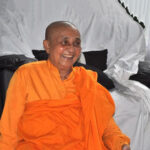Esoteric Teaching of Wat Phra Dhammakaya
Mano Mettanando Laohavanich 1

Abstract
Thailand‘s controversial Wat Phra Dhammakaya has grown exponentially. In just three decades, it has come to have millions of followers in and outside of Thailand and over forty branches overseas. The esoteric teaching of meditation taught by the leaders of the community has inspired thousands of young men and women from various universities to sacrifice their lives to serve their Master, something that has never been seen before in Thailand or elsewhere in the Theravada world. What is the nature of this esoteric teaching? Why is it so appealing to these young minds? These questions are discussed and analyzed by the author, who was one of Wat Phra Dhammakaya is founding members.
The rise of Wat Phra Dhammakaya as a well–organized urban Buddhist movement is undeniably unique in the history of Thailand. After three and a half decades, the wat is now a well–established international center of Buddhist movements. In addition to millions of followers in Thailand, it has over forty branches overseas, two satellite television stations broadcasting in four languages, and plans to construct an international university. All these achievements were possible without govern
Even during the 1970′s, the first decade of the wat, it was able to attract a huge mass of students to join its activities. Because the Cold War in Thailand was at its peak, the military highly suspected that the wat was involved with communism. The second decade saw a massive expansion of the community into neighboring areas. Thousands of acres of land were purchased for wide scale expansion of its physical territory, incurring protests and demonstrations from local farmers. The third decade saw the wat‘s involvement with grandiose financial investments, massive fund raising, and scandal over its mysterious administration. No Buddhist community in Thailand hit by similar scandals has managed to do more than just to survive, but Wat Phra Dhammakaya has continued to thrive.
Critics of the monastery often focus on the power of the financial management of the wat and the administration skills of its leaders as the source for its achievement. Its teaching of Dhammakaya meditation is simply judged as unorthodox. However, those with experience in the community know that the authority of its leadership is based on the charisma of Phra Chaiboon Dhammajayo which is in turn endorsed by the myths of esoteric teachings of Dhammakaya meditation. Legends about him and esoteric anecdotes he selectively delivers to his core followers are the foundation of his identity. Consequently, his words are taken as commandments.
Some of these legends, stories of miracles, and esoteric teachings are parts of the original teaching of the late abbot of Wat Paknam Bhasicharoen (Phra Monkhol–thep–muni), passed along by Phra Dhammajayo. When they are combined with the community discipline employed by the leadership of Wat Phra Dhammakaya, they create what may be the most charismatic Buddhist leadership that has ever existed.

I was once an insider and one of the leaders i< /span>n the board of administration of the wat who in 1989–90 successfully reformed the structure of the organization. I am also a scholar of Buddhism and the history of world religions. This gives me a unique perspective but also makes me take extra care in what I am about to present. I believe there is academic value in bringing to the attention of international scholars and theologians the esoteric teaching of Wat Phra Dhammakaya, which is apparently a new body of knowledge. Nevertheless, I have also realized the burden of impartiality that I should take as a scholar and the necessity to move away from prejudice and bias, pros and cons, in the issues which have deeply affected the course of my own life. This paper is, therefore, written with the intention neither to discredit nor to support Wat Phra Dhammakaya and its leadership, but to present the content of teaching which once I so deeply shared with other members of the Dhammakaya community in a way as impartial and objective as possible.
Read more, please download the file below.






